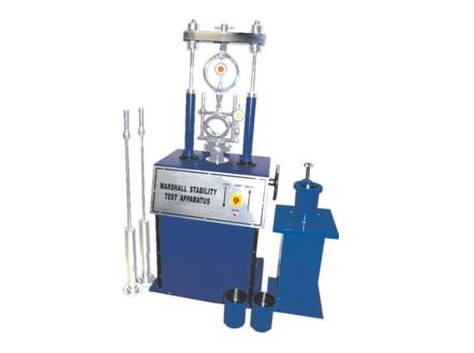

MARSHALL STABILITY TEST APPARATUS:
AS PER ASTM : D 1559 - T - 62
Introduction: Originally developed by Bruce Marshall, a highway engineer in U.S.A. later on standardized by ASTM. Generally the test is applicable to hot mix designs using bitumen and aggregates up to a maximum size of 25mm. In this method, the resistance to plastic deformation of cylindrical specimen of bituminous mixture is measured when the same is loaded at periphery at 5cm per min. This test procedure is used in designing and evaluating bituminous paving mixes. The test procedure is extensively used in routine test programmes for paving jobs. There are two major features of the Marshall method of designing mixes namely. a) Density - voids analysis b) Stability - flow tests. The Marshall stability of mix is defined as a maximum load carried by a compacted specimen at a standard test temperature of 600C. The flow value is deformation the Marshall test specimen under goes during the loading up to the maximum load, in 0.25 mm units. In this test and attempt is made to determine optimum binder content for the type of aggregate mix and traffic intensity.
General Description and Specifications: The apparatus consist of the following
Motorized Load Frame: 1 No.
A floor standing compression loading unit with two telescopic pillars and an adjustable cross head of 50 KN (5000 Kgf) capacity with motor and worm gear housed within the base unit, producing a platen speed of 50.8mm per minute. Limit switches are provided to cut off the platen over run on the downward travel. A handle is provided for manual operation during calibration etc. The load frame is fitted with ON –OFF, Reversing switch and power indicator lamp in front. Suitable to work on 230V, 50 Hz, AC single phase.
Compaction Pedestal: 1 No.
Compaction pedal with specimen mould holder.
Compaction Hammer: 2 Nos.
Compaction Rammers, 4.5 kg weight and free fall 45.7 cm.
Breaking Head Assembly: 1 No.
Consisting of upper and lower cylindrical segments with provision for fixing flow meter.
Marshal Moulds: 3 Nos.
Specimen mould 10.16 cm I.D. x 7.6 cm high with base plate and extension collar.
Specimen Extractor: 1 No.
Kit for specimen extraction consists of one each load transfer bar, steel ball, specimen extracting plate.
Optional Accessories at extra cost:
Office: S. N. 37/02, "Ashtavinayak Indl. Estate",
Parvati Nagar, Dhayari Narhe Road,
Next to Pari Robotics, Narhe, Pune-411041
Tel fax: (020) 24690312,
Email: sales@xeepl.com, xeepl.pune@gmail.com